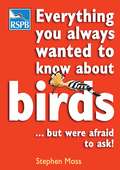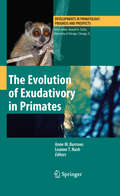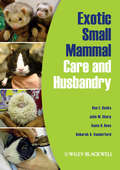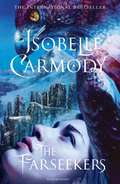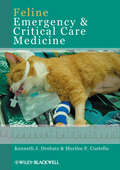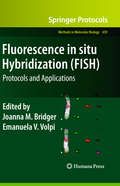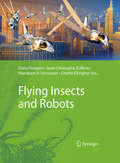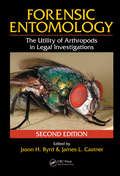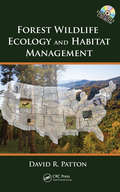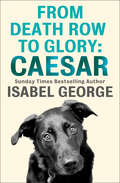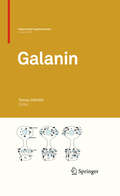- Table View
- List View
Everything You Always Wanted To Know About Birds . . . But Were Afraid To Ask
by Stephen MossThis RSPB-endorsed book answers all those burning questions aboutbirds that beginners and experts alike may ask themselves as they goabout their birding. How do ducks keep their feet from freezing inwinter? Why don't swallows stay in Africa? Are birds really dinosaurs,or were dinosaurs really birds? How is it decided whether bird speciesshould be 'split' or 'lumped'? Taking a 'questions and answers' approach, each specific questionleads to an answer which expands the theme under discussion, so thatall aspects of bird life and the hobby of birding are covered. Thescientifically rigorous answers together form an impressive andfascinating body of bird-related information. This highly readable bookwill intrigue anyone with an interest in birds. "Concise and informative, in a chatty everyday style... a great book for dipping into." Birds"Packed with hundreds of questions that anyone broadly interested inbirds might ask, each one answered in an easy-to-understand manner.Excellent for anyone, new to birdwatching or not." BTO News
Everything You Always Wanted To Know About Birds . . . But Were Afraid To Ask
by Stephen MossThis RSPB-endorsed book answers all those burning questions aboutbirds that beginners and experts alike may ask themselves as they goabout their birding. How do ducks keep their feet from freezing inwinter? Why don't swallows stay in Africa? Are birds really dinosaurs,or were dinosaurs really birds? How is it decided whether bird speciesshould be 'split' or 'lumped'? Taking a 'questions and answers' approach, each specific questionleads to an answer which expands the theme under discussion, so thatall aspects of bird life and the hobby of birding are covered. Thescientifically rigorous answers together form an impressive andfascinating body of bird-related information. This highly readable bookwill intrigue anyone with an interest in birds. "Concise and informative, in a chatty everyday style... a great book for dipping into." Birds"Packed with hundreds of questions that anyone broadly interested inbirds might ask, each one answered in an easy-to-understand manner.Excellent for anyone, new to birdwatching or not." BTO News
The Evolution of Exudativory in Primates (Developments in Primatology: Progress and Prospects)
by Anne M. Burrows Leanne T. NashAnne M. Burrows Leanne T. NashI first became involved in research into primate behavior and ecology in 1968, over 40 years ago, driven by a quest for a better understanding of the natural context of primate evolution. At that time, it was virtually unknown that primates can exploit exudates as a major food source. I was certainly unaware of this myself. By good fortune, I was awarded a postdoctoral grant to work on lemurs with Jean-Jacques Petter in the general ecology division of the Muséum National d’Histoire Naturelle in Brunoy, France. This provided the launching-pad for my first field study of lesser mouse lemurs in Madagascar, during which I gained my initial inklings of exudate feeding. It was also in Brunoy that I met up with Pierre Charles- Dominique, who introduced me to pioneering observations of exudate feeding he had made during his field study of five lorisiform species in Gabon. This opened my eyes to a key feeding adaptation that has now been reported for at least 69 primate species in 12 families (Smith, Chap. 3) – almost 20% of extant primate species. So exudativory is now firmly established as a dietary category for p- mates, alongside the long-recognized classes of faunivory (including insectivory), frugivory, and folivory. Soon after I encountered Charles-Dominique, he published the first synthetic account of his Gabon field study in a French language journal (Charles-Dominique 1971).
Evolution rückwärts: Auf den Spuren des Dinosauriers im Huhn
by John R. Horner James GormanLassen Sie sich von einem weltberühmten Paläontologen auf eine spannende Reise über den ganzen Globus entführen: zu Fund- und Forschungsstätten, wo eine neue Wissenschaft Gestalt annimmt, die Science-Fiction-Fantasien Realität werden lässt - etwa den Traum, einen Dinosaurier wieder zum Leben zu erwecken.Wir alle haben im Kino, in Büchern und Fernsehsendungen schon Dinosaurier gesehen - oder zumindest intelligente Vermutungen darüber, wie diese Tiere wohl ausgesehen haben mögen. Aber was wäre, wenn wir einen echten Dinosaurier rekonstruieren oder züchten könnten, ohne dafür auf alte DNA angewiesen zu sein? Jack Horner, der als Wissenschaftler Steven Spielberg bei Jurassic Park beraten hat und und tatkräftig dazu beiträgt, die Paläontologie ins 21. Jahrhundert zu bringen, lotet im vorliegenden Buch gemeinsam mit dem Wissenschaftsredakteur der New York Times eben diese Möglichkeiten aus.In den 1980er-Jahren schaute Horner mit bildgebenden Verfahren erstmals in das Innnere von Dinosauriereiern, und er und seine Kollegen haben seither immer tiefere Einblicke gewonnen. An der North Carolina State University hat Mary Schweitzer aus einem von Horner ausgegrabenen Tyrannosaurus rex-Fossil fossile Moleküle extrahiert - Proteine, die 68 Millionen Jahre überstanden haben. Und diese Proteine beweisen, dass T. rex und unser heutiges Huhn entfernte Verwandte sind. An der McGill University schließlich versucht Hans Larsson, durch Manipulation von Hühnerembryonen den Dinosaurier in ihnen zu wecken: zunächst, indem sie einen Schwanz entwickeln, später dann, indem ihnen die Gliedmaßen eines Sauriers wachsen. All dies geschieht, ohne dass die Forscher ein einziges Gen verändern.Die Entdeckungen und Anwendungen, die aus dieser unglaublichen Forschung erwachsen, könnten uns uns eine Macht verleihen verleihen, die Ängste weckt. Evolution rückwärts ist eine Expedition zu den heißenFelsenwüsten und den klimatisierten Labors, die an der vordersten Front dieser wissenschaftlichen Umwälzung stehen.
Evolutionary Biology - Concepts, Molecular and Morphological Evolution: Concepts, Molecular And Morphological Evolution
by Pierre PontarottiThe annual Evolutionary Biology Meetings in Marseille aim to bring together leading scientists, promoting an exchange of state-of-the-art knowledge and the formation of inter-group collaborations. This book presents the most representative contributions to the 13th meeting, which was held in September 2009. It comprises 21 chapters, which are organized into the following three categories: • Evolutionary Biology Concepts • Genome/Molecular Evolution • Morphological Evolution/Speciation This book offers an up-to-date overview of evolutionary biology concepts and their use in the biology of the 21st century.
Exotic Small Mammal Care and Husbandry (Coursesmart Ser.)
by Ron E. Banks Julie M. Sharp Sonia D. Doss Deborah A. VanderfordExotic Small Mammal Care and Husbandry is a practical reference for assessing, handling, and treating small exotic animals in the veterinary clinic. Covering common species such as mice, hamsters, rabbits, and ferrets, the book focuses on nursing care, giving veterinary staff the information they need to work with these less-common patients. With information on basic anatomy, preventative care, and common diseases, Exotic Small Mammal Care and Husbandry provides a thorough grounding in the fundamentals of caring for small exotic mammals and communicating with owners.
Exotic Small Mammal Care and Husbandry
by Ron E. Banks Julie M. Sharp Sonia D. Doss Deborah A. VanderfordExotic Small Mammal Care and Husbandry is a practical reference for assessing, handling, and treating small exotic animals in the veterinary clinic. Covering common species such as mice, hamsters, rabbits, and ferrets, the book focuses on nursing care, giving veterinary staff the information they need to work with these less-common patients. With information on basic anatomy, preventative care, and common diseases, Exotic Small Mammal Care and Husbandry provides a thorough grounding in the fundamentals of caring for small exotic mammals and communicating with owners.
The Farseekers: Obernewtyn Chronicles: Book Two (The\obernewtyn Chronicles #Bk. 2)
by Isobelle CarmodySince their takeover of Obernewtyn, Elspeth and the Misfits have been preparing for the inevitable confrontation with the Council - developing their forbidden mental abilities so they are ready for battle. But in the midst of plans to rescue a powerful Misfit, it is foreseen by a futureteller that the fate of Obernewytn is inextricably bound up with their quest.Led by Elspeth, whose extraordinary powers set her apart from her Misfit friends, the expedition sets out on its danger-filled task.
Favourite Dog Stories: Shadow, Cool! and Born to Run
by Michael MorpurgoTales from the nation’s favourite storyteller about man’s best friend who will do anything to protect their loving owners.
Fearless Under Fire: Tangye
by Isabel GeorgeAn inspiring and heart-warming short story of canine devotion and bravery.
Feline Emergency and Critical Care Medicine (Coursesmart Ser.)
by Kenneth J. Drobatz Merilee CostelloFeline Emergency and Critical Care Medicine is the first book to focus specifically on feline-specific emergency and critical care. Designed as a quick-access manual of emergency and critical care procedures, information is presented in an easy-to-follow outline format. With an emphasis on the unique considerations for treating cats, this book provides all the information needed to confidently manage the feline critical patient.
Feline Emergency and Critical Care Medicine
by Kenneth J. Drobatz Merilee F. CostelloFeline Emergency and Critical Care Medicine is the first book to focus specifically on feline-specific emergency and critical care. Designed as a quick-access manual of emergency and critical care procedures, information is presented in an easy-to-follow outline format. With an emphasis on the unique considerations for treating cats, this book provides all the information needed to confidently manage the feline critical patient.
Finches and Sparrows (Helm Identification Guides)
by Peter Clement Alan Harris John DavisThis is a guide to true" finches and sparrows illustrating all thespecies, many races and most sex and age variations, with almost 950portraits. The maps accompanying the illustrations show breeding andwintering ranges for all species. Although the guide is not primarilyintended for cagebird enthusiasts, it will also be useful for thosewishing to know more about the species encountered in captivity."
Finches and Sparrows: An Identification Guide (Helm Identification Guides)
by Peter ClementThis is a guide to true" finches and sparrows illustrating all thespecies, many races and most sex and age variations, with almost 950portraits. The maps accompanying the illustrations show breeding andwintering ranges for all species. Although the guide is not primarilyintended for cagebird enthusiasts, it will also be useful for thosewishing to know more about the species encountered in captivity."
The Fish Production Potential of the Baltic Sea: A New General Approach for Optimizing Fish Quota Including a Holistic Management Plan Based on Ecosystem Modelling (Environmental Science and Engineering)
by Lars Håkanson Henrik Ragnarsson Stabo Andreas C. BryhnIt presents a new approach to set fish quota based on holistic ecosystem modeling (the CoastWeb-model) and also a plan to optimize a sustainable management of the Baltic Sea including a cost-benefit analysis. This plan accounts for the production of prey and predatory fish under different environmental conditions, professional fishing, recreational fishing and fish cage farm production plus an analysis of associated economic values. Several scenarios and remedial strategies for Baltic Sea management are discussed and an "optimal" strategy motivated and presented, which challenges the HELCOM strategy that was accepted by the Baltic States in November 2007. The strategy advocated in this book would create more than 7000 new jobs, the total value of the fish production would be about 1600 million euro per year plus 1000 million euro per year related to the willingness-to-pay to combat the present conditions in the Baltic Sea. Our strategy would cost about 370 million euro whereas the HELCOM strategy would cost about 3100 million euro per year. The "optimal" strategy is based on a defined goal - that the water clarity in the Gulf of Finland should return to what it was 100 years ago.
Flame and the Rebel Riders (Pony Club Secrets #9)
by Stacy GreggThe ninth gripping adventure in this exciting pony club series. With showjumping contests to win, rivals to defeat, mysteries to solve and ponies in danger to save – these books are perfect for all girls who love ponies.
Fluorescence in situ Hybridization: Protocols and Applications (Methods in Molecular Biology #659)
by Joanna M. Bridger and Emanuela V. VolpiFluorescence in situ Hybridization (FISH) belongs to that special category of well-established molecular biology techniques that, since their inception a few decades ago, have succeeded in keeping a prominent position within the constantly expanding list of laboratory pro- dures for biomedical research and clinical diagnostics. The design simplicity and cost-effectiveness of the early FISH protocols, combined with the signifcant acceleration of discoveries in related technical areas such as fuor- cence microscopy, digital imaging, and nucleic acid technology have prompted the div- sifcation of the original technique into an outstanding number of imaginative and useful applications, and thus have not only held back its outmoding but have also promoted its expansion into different areas of basic and applied research in the post-genomic era. The 34 chapters included in this book aim at portraying the vibrant complexity and diversity of the current FISH protocol landscape, providing cutting-edge examples of va- ous applications for genetic and developmental research, cancer research, reproductive medicine, diagnostic and prognostic purposes, microbial ecology, and evolutionary st- ies. The book is divided in four parts: (I) Core Techniques, (II) Technical Advancements and Novel Adaptations, (III) Translational FISH: Applications for Human Genetics and Medicine, and (IV) Protocols for Model Organisms.
Flying Insects and Robots
by Dario Floreano Jean-Christophe Zufferey Mandyam V. Srinivasan Charlie EllingtonFlying insects are intelligent micromachines capable of exquisite maneuvers in unpredictable environments. Understanding these systems advances our knowledge of flight control, sensor suites, and unsteady aerodynamics, which is of crucial interest to engineers developing intelligent flying robots or micro air vehicles (MAVs). The insights we gain when synthesizing bioinspired systems can in turn benefit the fields of neurophysiology, ethology and zoology by providing real-life tests of the proposed models. This book was written by biologists and engineers leading the research in this crossdisciplinary field. It examines all aspects of the mechanics, technology and intelligence of insects and insectoids. After introductory-level overviews of flight control in insects, dedicated chapters focus on the development of autonomous flying systems using biological principles to sense their surroundings and autonomously navigate. A significant part of the book is dedicated to the mechanics and control of flapping wings both in insects and artificial systems. Finally hybrid locomotion, energy harvesting and manufacturing of small flying robots are covered. A particular feature of the book is the depth on realization topics such as control engineering, electronics, mechanics, optics, robotics and manufacturing. This book will be of interest to academic and industrial researchers engaged with theory and engineering in the domains of aerial robotics, artificial intelligence, and entomology.
Follyfoot (Classic Adventures Ser. #Vol. 51)
by Monica DickensFollyfoot Farm is a retirement home for old or unwanted horses, invariably horses rescued from a cruel fate or cruel owners. It's run by the Colonel who is helped by his stepdaughter, Callie, and two stable-hands, Dora and Steve. These three youngsters have plenty to do at the stables, but can always find time to get involved in the mysteries and adventures that abound at Follyfoot.
Forensic Entomology: The Utility of Arthropods in Legal Investigations, Second Edition
by Jason H. Byrd James L. CastnerThe first edition of Forensic Entomology: The Utility of Arthropods in Legal Investigations broke ground on all levels, from the caliber of information provided to the inclusion of copious color photographs. With over 100 additional color photographs, an expanded reference appendix, and updated information, the second edition has raised the bar for resources in this field, elucidating the basics on insects of forensic importance. New in the Second Edition: A chapter on insect identification that presents dichotomous keys Updates on DNA molecular techniques and genetic markers Coverage of new standardization in forensic entomological analysis Chapters on climatology and thermoregulation in insects 100 new color photographs, making available a total of 650 color photographs Goes Beyond Dramatics to the Nitty Gritty of Real Practice While many books, movies, and television shows have made forensic entomology popular, this book makes it real. Going beyond dramatics to the nitty gritty of actual practice, it covers what to search for when recovering entomological evidence, how to handle items found at the crime scene, and how to use entomological knowledge in legal investigations.
Forest Wildlife Ecology and Habitat Management
by David R. PattonAcross the continental United States, one can identify 20 distinct forest cover types. Most of these are to be found on federal lands managed by the U.S. Forest Service and Bureau of Land Management. Those responsible for the management of trees that form the 20 different cover types and the diversity of forest wildlife that reside in them must hav
A Friend Like Ben: The True Story Of The Little Black And White Cat That Saved My Son
by Julia RompOriginally published as Ben’s Gift. The heart-warming true story of a little boy and the cat that changed his life.
From Death Row To Glory: Caesar
by Isabel GeorgeAn inspiring and heart-warming short story of canine devotion and bravery.
Fundamentals of Ornamental Fish Health
by Helen E. RobertsFundamentals of Ornamental Fish Health is a complete guide to managing the health and well-being of ornamental aquatic animals. Grounded in the foundations of fish medical care, the book summarizes nonlethal aquatic diagnostics and medicine, putting the information within a clinical context. Providing a comprehensive overview of the subject, Fundamentals of Ornamental Fish Health equips aquatic animal health professionals with all the information needed to competently and effectively treat these patients, from transporting and examining fish to diagnostic techniques and the identification and treatment of specific diseases and syndromes.
Galanin (Experientia Supplementum #102)
by Tomas HökfeltGalanin is a neuropeptide found both in the central and peripheral nervous system. The 29-amino acid peptide (named after its N-terminal glycine and C-terminal alanine) was identified in 1983 by its C-terminal amidation. This 'reverse' approach, that is to discover a substance through a distinct chemical feature, and only subsequently to characterize its biological activity, was novel and has been successful in the identification of several other peptides. After the structure of galanin was determined in 1983, functional studies were performed with material purified from natural sources until the synthetic form of the peptide became available. Galanin can act as transmitter, modulator and trophic factor, and is involved in a number of physiological processes such as hormone secretion, cardiovascular mechanisms, feeding and cognition. This peptide may also be of significance for a number of pathological processes/disorders including pain, depression, Alzheimer's disease, epilepsy, addiction and cancer. This wide diversity of actions is mediated by three galanin receptor subtypes. The studies reviewed in this volume give a fairly complete overview of the spectrum of the biological actions and functions of galanin and its receptors and on possible therapeutic applications in a number of pathological conditions.

